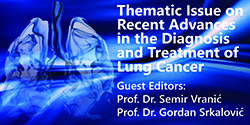Characterization and Clinical Significance of EIF1AX Mutations and Co-Mutations
DOI:
https://doi.org/10.5644/ama2006-124.322Keywords:
EIF1AX, Thyroid Nodule, Cytopathology, Next-Generation SequencingAbstract
Objective. Mutations in the EIF1AX gene have been recently detected in a small percentage of benign and malignant thyroid lesions. We sought to investigate the prevalence and clinical significance of EIF1AX mutations and co-mutations in cytologically indeterminate thyroid nodules at our institution.
Materials and Methods. A 5-year retrospective analysis was performed on thyroid nodules with a cytologic diagnosis of Bethesda category III or IV, which had undergone testing by our in-house next generation sequencing panel. Surgically resected nodules with EIF1AX mutations were identified, and mutation type and presence of co-mutations were correlated with histopathologic diagnosis.
Results. 41/904 (4.5%) cases overall and 26/229 (11.4%) surgically resected nodules harbored an EIF1AX mutation. The most common histologic diagnoses were follicular thyroid carcinoma and follicular variant of papillary thyroid carcinoma. 11/26 (42.3%) of nodules had isolated EIF1AX mutation. Co- mutations were found in RAS (12/26; 46.2%), TERT (5/26; 19.2%) and TP53 (2/26; 7.7%). EIF1AX mutation alone conferred a 36.4% risk of malignancy (ROM) and 54.5% ROM or noninvasive follicular thyroid neoplasm with papillary-like nuclear features (NIFTP), while the ROM was significantly higher in nodules with concurrent RAS (71.4%), TERT, TP53 and RAS+TERT (100%) mutations.
Conclusion. EIF1AX mutations occur in benign and malignant follicular thyroid neoplasms. In our cohort, the majority of mutations occurred at the splice acceptor site between exons 5 and 6. Importantly, the coexistence of EIF1AX mutations with other driver pathogenic mutations in RAS, TERT and TP53 conferred a 100% ROM or NIFTP, indicating that such nodules require surgical removal.
Downloads
Published
Issue
Section
License
Copyright (c) 2021 Stacey M. Gargano, Nitika Badjatia, Yanina Nikolaus, Stephen C. Peiper, Zi-Xuan Wang

This work is licensed under a Creative Commons Attribution-NonCommercial 4.0 International License.






